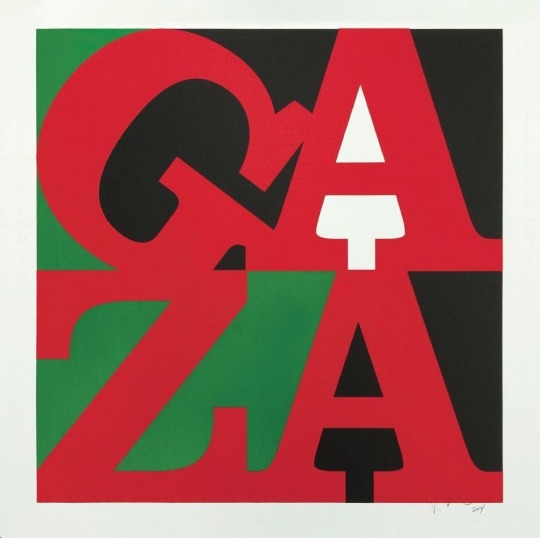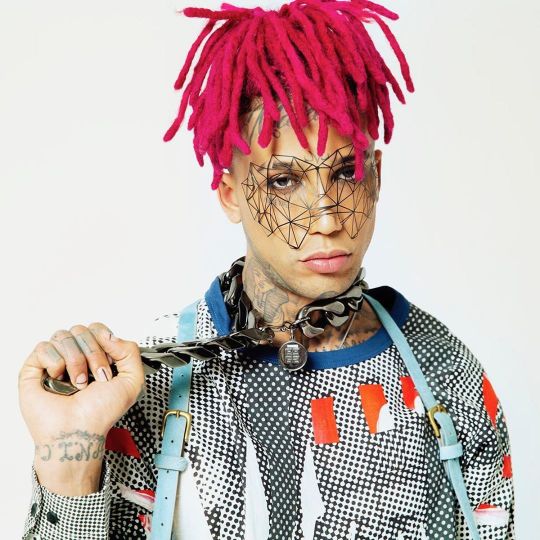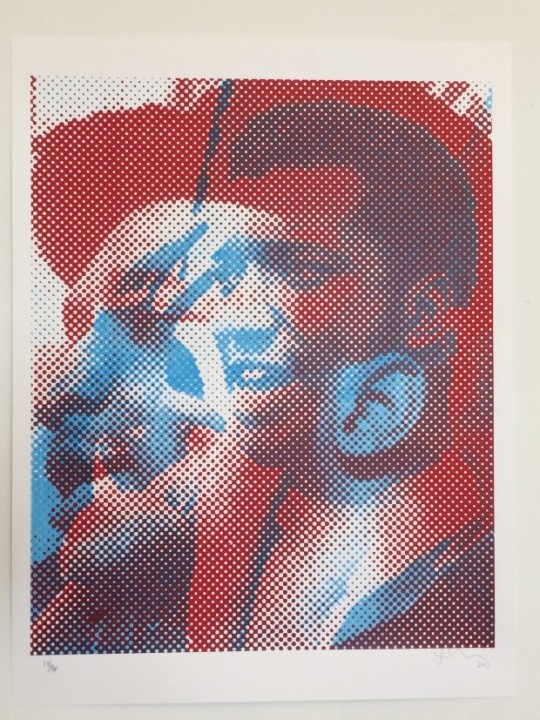#Kyle Goen
Text









Love (1964) by Robert Indiana (American, 1928 – 2018) & Long Live Palestine, Long Live Gaza by Kyle Goen (American)
Montage by Jeffrey Earp - 2023
#art#contemporary art#protest art#political art#Robert Indiana#Kyle Goen#israeli palestinian conflict#palestine#israel#gaza#gaza strip#jeffrey earp#montage
57 notes
·
View notes
Photo


About | Under the Mush
Under The Mush was an online magazine founded by Christie Neptune and co-founded by Cassandra Waldrop during their Junior and Freshman year of college in 2007. With the help of friends from college, community members and a strong family base of support Neptune and Waldrop ran UTM for 5 years.
Under The Mush began as an online blog and monthly television show on Brooklyn Community Access Television (BCAT). It was relaunched in 2010 and made exclusively available online. The magazine ceased operations in 2012. Under The Mush covered a range of topics in Music, Culture, Fashion, and Lifestyle in both video and print format.
Artists featured included: Amanda Blank, J*Davey, 88 Keys, Kyle Goen, Kiran Goraya, Ninjasonik, Damien Lemon, Shani Peters, Nikayatu Jusu, DJ Eclipse, Jackie Christie, Mac Premo, Oliver Jeffers, and Johnny Go Figure among others.
Video Archive: https://vimeo.com/underthemush
Contributors:
Christie Neptune, Culture
Cassandra Waldrop, Events and Culture
Christina Edwards, Lifestyle
Rocky Knights, Events and Lifestyle
Steve Beckford, Music
Marlena Batts, Fashion
Daiquan Stevens, Music
Christopher Neptune, Music Composition and Production
Kareem Wallace, Photographer
Aubrey Stallard, Photographer
Gian Carlo, Videographer and Editor
Anthony Slyvester, Videographer, and Editor
Brett Rodel, Editor
0 notes
Text





some powerful posts i saw on instagram recently
#the crowd was holding umbrellas and roses#the police used tear gas#&flashbangs &rubber bullets &other explosives#fuck the cops#fuck the police#acab#blm#seattle protests#direct action#seattle#also posting these cause so many posts ive seen about this protest have been immediatly dissapearing
0 notes
Photo

This was a fun one! Kyle Goen and I concocted this fantasy space world using projections for @universalmusicgroup artist @KidBuu .. His stage name is derived from a villain from the popular Japanese anime series Dragon Ball Z. His song "Death 2 Soundcloud" received over 10 million views on YouTube. Some in camera, some not, some both. Space and color makes not a dull shoot. Styling - @brookelyn_styles Grooming - @thisjenna Art Dir - @monique.m.morrison 1st Assistant Lighting @john_collazos Digital Tech @Maria Noble Creative Director - #KyleGoen #SpacePhotography #KidBuu #PiperFergusonPhotography -- http://www.piperferguson.com https://www.instagram.com/p/B5vyrl_BzlW/?igshid=3r83ebrzm8h
0 notes
Text
Loyalty Official Trailer 2018
Available May 16 2018: The On Channel www.theonchannel.com
"LOYALTY" A film written & produced by Christina Cooper. 🎬 Contact:[email protected]
"LOYALTY" film CREDITS
Directors:
Christina Cooper
Steven Alan Davis
Producer/Writer:
Christina Cooper
Main cast -
Jamal R. Henderson plays DAVONTE
Chris Massey plays REX
Christina Cooper plays BRIA
Viandra Dunn plays SIERRA
Dawn Raven plays ALLISON
Byron Haskins plays KESEAN
Kyle Lewis plays EJ
Carlene Corsey plays MAMA DEE
Stephanie Tejada plays JESSICA
Featured extras -
Guy rolling dice #1: Aaron Green
Guy rolling dice #2: Ledale Smith
Guy with pitbull: Trave' Harris
Third robber: Duane walker
School girl: Amya Mair
Girl #1: Tymera Finley
Girl #2: Jameisha Havard
Cinematographers: Stevie Murrell & Joshua Rieger
Script Advisor: Jennifer Cooper
1st AD: Kimisha Gill
Bts photographer: PatrickLee Hamilton
Bts videographer: Joshua Rieger
Set production: Ray Choi
Boom OP: Alex Goens
Key make up: Julie Jules
Wardrobe: Shatora Irby
Hairstylist: Anne Guerrier
0 notes
Text
Hyperallergic: As Palestinian #DignityStrike Passes One-Month Mark, New York Artists Illuminate the Struggle
Poster of artist contributions to the Dignity Strike after 30 days, designed by Kyle Goen/Decolonize This Place, “Tadamoun” (2017) (all images courtesy Decolonize This Place unless otherwise noted)
Today, the historic hunger strike by 1,500 Palestinian prisoners in Israeli jails reaches its 31-day mark, coinciding with the commemoration on Monday of the 69th anniversary of the Nakba (disaster), the name given to the violent displacement of 800,000 Palestinians from their homes that accompanied the founding of the state of Israel in 1948. As Vijay Prashad has recently pointed out, the Palestinian hunger strike has now gone on longer than than the famous strikes of Gandhi during the Indian independence struggle (the longest of which lasted 21 days). Despite media offensives against the strike by Israel and punitive acts of psychological warfare against the strikers themselves, the prisoner’s movement appears steadfast in pressing their immediate demands concerning issues like visitation rights, legal services, and administrative detention. Yet beyond prison walls, the strike has also had the effect of galvanizing Palestinian civil society across sectarian divides, with imprisonment itself being taken up as a metaphor for the condition of all Palestinians living under a colonial occupation that is widely seen as being facilitated by the Palestinian Authority itself. Mobilizations of all kinds are taking place across the West Bank and Gaza, raising the specter of a new intifada. Hunger strikes are being undertaken by the mothers of several prisoners; solidarity tents have sprung up throughout cities as hubs of information, organizing, and mutual aid; boycotts, strikes, rallies, and marches are happening constantly, intensifying on “days of rage” that have seen clashes with settlers and the IDF (during which 20-year old Saba Nidal Obaid was killed by soldiers last week). Woven throughout all of the above has been a proliferation of art forms — installations, posters, chants, music, and performative actions of all kinds, like the couple who recently were married inside a make-shift jail cell erected at one of the solidarity camps — that are in turn re-mediated through global solidarity networks as photographs, videos, and memes (such as the “salt water challenge“) via Facebook, Twitter, and Instagram.
Decolonize This Place/Illuminator projection, New York City Hall, on Tuesday, May 9, 2017
Political action, the making of art, and the intersection of the two can involve many senses of time, from rapid-response tactics measured in hours, to drawn-out campaigns over the course of years and generations. These must be woven together at different scales, rhythms, and horizons to remain both flexible and enduring in the face of deep-seated structures of oppression.
The question of time imposes itself with special intensity in the case of Visibility Sustains the Struggle, a participatory initiative launched last month by the artist-organizers of Decolonize This Place in solidarity with the hunger strike and the Palestinian freedom movement more generally.
Working in-between the streets and social media platforms over the past month, Visibility Sustains the Struggle has involved an open invitation to artists and activists around the world to submit videos, images, writings, songs, and actions to a circulating archive of that continues to grow as the strike enters its second month.
Among the images adopted by those supporting the strike both in Palestine and across the world is a row of hand-drawn tally marks, organized into groups of five with the fifth mark as a diagonal strike. This simple image hauntingly evokes the walls of a prison cell and the most elementary form of marking the time of incarceration: one day after another, a testimony to the both misery of imprisonment, but also a persistent will to endure. Since the strike commenced on April 17th, a single mark has been added to the image every day, an indicator of both determination but also the ever-inscreasing physical debilitation of the prisoners themselves (over the past week, 76 strikers have been hospitalized, and Israel has still shown no willingness to negotiate).
Decolonize This Place/Illuminator projection at building housing the offices of Artis, May 9, 2017
With the major exception of an editorial published in the New York Times on the first day of the strike by Marwan Barghouti — which pro-Israeli media monitors forced the paper to retroactively qualify with a Zionist version of Barghouti’s biography, which characterized him as a terrorist — the strike has been largely ignored by liberal US media, whose track record on Palestine is dubious to the say the least to begin with. In turn, despite the historic nature of the strike and its potential ramifications for the region, it has barely registered among most self-described progressive activists and intellectuals in the US, for whom Palestine continues to either be politically remote or a point of explicit discomfort and reaction (hence the acronym PEP — progressive except Palestine).
Shining through this media blackout, it was quite remarkable to witness last Tuesday, May 9th evening the iconic tally-marks of the prisoners’ movement projected by the Illuminator at a gigantic scale on buildings throughout Manhattan, transposing the wall of the prison cell to a network of sites involved in variously funding, supporting, and whitewashing Israeli apartheid and settler-colonialism. These included the New York headquarters of Leumi Bank, the Israeli Development Bank, the pro-Israel arts nonprofit Artis, and finally City Hall, where liberal councilmembers and indeed the mayor himself have consistently taken every opportunity to blindly lend unwavering moral and political support to Israel. An especially powerful projection was that aimed at the neo-classical facade of City Hall (a structure, it should be remembered, that was built using slave labor in the early nineteenth century on stolen Native American land). Here, the row of rough hewn tally-marks were set off like prison bars against the soaring verticality of the Corinthian columns and the timeless values of democracy they are meant to communicate. Bringing the occupation home, the building was thus transformed into what Illuminator operator Kyle Depew calls a temporary “counter-monument” to Palestinian resistance, one that now survives and circulates as a media image within the larger assemblage of the campaign.
Images of Dignity Strike-related protest in the West Bank city of Ramallah
In each of its iterations, the tally-marks were supplemented with the phrase “Dignity Strike,” which has also been the primary hashtag of the Visibility Sustains the Struggle initiative. As artist and organizer Amin Husain explains, “Hunger strike is the tactic and the immediate demands concerning the conditions of the prisoners are quite precise; but the prisoners movement has continuously emphasized that it is dignity and freedom of all Palestinians that are at stake. This strike has broad ramifications at a moment when Oslo and the two-state solution are dead, the resistance is jailed, neoliberalism runs rampant, and the PA is a petty-bourgeois adjunct to the occupation in the manner identified by Frantz Fanon long ago. Israel is intent on showing that resistance is futile, that Palestinians must roll over and accept their fate. The prisoners and their bodies are at the threshold of this attack on the Palestinian capacity to resist at all.”
It is seen against this background that the specific demands of the strike such as an end to administrative detention and solitary confinement, improved visitation and communication rights (including the simple right to physically touch family members), and expanded access to legal, medical, and education services ultimately take on the status of a more general assertion of human dignity that is radically defiant to the psychological warfare that is essential to the occupation overall.
(Top) Demonstration in Ramallah, May 5, 2017; (Bottom) Graffitti in Aida Refugee Camp, Bethlehem.
Along with the tally-marks, other graphics and messages were projected as well over the course of this psychogeographic mapping of the city, each dynamically interacting site-specifically with the various architectural surfaces in a manner recalling the Illuminator’s art-historical predecessor, Kyrzytof Wodiszcko. In one graphic, the lower half of a man’s face with its mouth bound shut (an icon widely used by the prisoner’s movement) is projected in such a way as to uncannily anthropomorphize the facade of the building itself; in another, a silhouetted outline of Palestine appears bisected by the shape of a contracted stomach, thus transforming the territory into a kind of collective national body. In yet another, the movement declaration “Our Chains Will Be Broken Before We Are” projected in white against a vertical black rectangle decorated at either end by the latticework of the Palestinian keffiyeh. This image brought to architectural scale a sticker with the same design that has been appearing on surfaces throughout the city for the past month, and the same motif was also used in an actual 25-foot Dignity Strike banner unfurled by demonstrators at the various sites alongside the projections. The aesthetics of the banner echoed those designed by the Direct Action Front For Palestine over the past few years, including a series of 11 Black Lives Matter banners deployed during protests following the failure to indict the NYPD murderer of Eric Garner (11 alluding to the number of times Garner uttered “I Can’t Breathe” as he was choked to death).
“Decolonize this Place” stenciled on the West Bank Barrier (aka Apartheid wall) in Bethlehem
This was but one connection between the #dignitystrike projections and the broader network of artists and organizers that developed under the rubric of Decolonize This Place over the past year, including the three-month residency at the alternative arts venue Artists Space last fall. More than a show of political art, Decolonize this Place transformed the gallery into a round-the-clock movement hub facilitating linkages between struggles including de-gentrification, global wage workers, Black liberation, Standing Rock, Puerto Rican debt-resistance, and Free Palestine, among others. Palestine has been essential part of the work of Decolonize This Place. As Kyle Goen — an artist involved in creating much of the graphic repertoire for the project — explains, “Far from an isolated and remote struggle, the occupation of Palestine and the movement against it bears deep affinities with decolonial movements in the United States, from the water protectors of Standing Rock to the anti-displacement activists in Bronx.” These were among the places that were name-checked in the projections on Tuesday night, reminding us that the grammatical shifter “this” in “Decolonize This Place” is an mobile imperative linking together different sites and histories depending on where it is uttered.
As photographer and organizer Andres Rodriguez of the Comite Boricua en la Disapora put it while documenting the projections on Tuesday, “The Palestinian and Puerto Rican struggles are both anchored in an acknowledgment of settler colonialism, in our case for hundreds of years: domination through monopolizing violence, illegal debts and economic extraction, criminalizing resistance: in such shared conditions we find the bases of potential unity and collective liberation as oppressed peoples. Even through small acts of resistance and solidarity we build our self-determination and preserve our dignity.”
Young men gather after the funeral of Saba Nidal Obaid in Nabi Saleh, North of Ramallah, May 12
Also on site was filmmaker Aiko Maya Roudette, who added, “In the United States we are all implicated in a toxic relationship between the white supremacist settler-colonial power within which we live, and that of Israel — a relationship which has already grown stronger with Trump, who is set to make his first visit to Israel in two weeks.” This point was implicitly driven home in the Tuesday projections as well when the phrase “Financing Fascism” appeared between US and Israeli flags flanking the entrance to the Bank of Israel in midtown, challenging the comfortable use of the term “fascism” by many PEPs when describing Trump while ignoring the ethnocidal project of one of the US’ closest military allies.
This complicity is as true in the art system as it is in US society more broadly. Among the actions undertaken in the fall by Decolonize this Place was a campaign targeting Artis, the non-profit arts organization that works to promote Brand Israel in the United States, effectively artwashing the Occupation. Artis makes a point of refusing direct funding from Israeli government, thus putting it technically beyond the purview of the BDS movement even as it still happily does the job of forging connections and legitimacy between the global art scene and Israel.
Solidarity banner by striking Puerto Rican students, May 5, 2017 (Image courtesy of Comite Boricua En La Diaspora)
It was thus especially significant that Visibility Sustains the Struggle returned on Tuesday night to the offices of Artis, now reciprocally reframing the earlier action in light of the Dignity Strike and vice-versa. On the one hand, this demonstrated that the meta-demand for Palestinian dignity was always already at stake in the BDS action, and that BDS per se is “the floor not the ceiling” as signs at the action had announced, a limited tactic rather than a goal in of itself. On the other hand, it also reminded us that BDS remains one of the few concrete tools available to people in the US for effectively increasing the economic and moral costs for Israel of the occupation.
Whether in Northern Ireland, South Africa, or the United States, prison hunger strikes use the most elemental weapon available to prisoners — control over their own bodies — to interrupt business as usual in the carceral system. The tactic forces jailers into a decision dilemma in which they have no good options. In some cases this means the jailers being forced into negotiations, while in others it results in even more brutal measures against strikers, such as force-feeding (a technique currently being considered by Israel, despite a refusal to comply by doctors), or, in extreme cases, allowing prisoners to expire — an option that Israel has indeed overtly invoked in the past. In any event, the determination of the prisoners — and the calculus of the jailers — is deeply impacted by the extent to which the strike is seen and heard beyond prison walls.
Decolonize This Place/Illuminator projections, Leumi Bank and Israeli Development Bank, Midtown Manhattan, May 9, 2017
A sense of helplessness or even anesthesia can easily set in when we consider the monolithic support of Israel by even our supposedly progressive representatives like New York Mayor de Blasio and US Senator Bernie Sanders, not to mention Israel’s longstanding imperviousness to international censure. Were projections like those on Tuesday night feel-good but otherwise futile gestures of solidarity? No, says Marz Saffore of Decolonize This Place, who has been working to coordinate the expansive social media campaign over the past month including videos, images, writings, and and actions contributed by artists and activists all over the world. “With Visibility Sustains the Struggle, we are operating in a time-horizon of decolonization, with art understood as a training in the practice of freedom that takes place over years and decades,” Saffore says. “Each action, each image, each strike, each relationship built in turns creates space and time for further movement in undoing the entrenched systems of white supremacy and settler-colonialism. Visibility Sustains the Struggle is first a foremost a contribution to the global upsurge in support and visibility for the hunger strikers; but it is also a call to recognize the essential importance of prisoner’s struggles around the world, including those of black freedom movement in the United States. This initiative concerns Palestine, and by extension, how we organize here and what is at stake in our own day-to-day work of liberation. The Palestinian and Black struggles are not only structurally linked, but they require one another to flourish.”
Day after day, the tally-marks of the Dignity Strike banner will continue to grow — until they stop. How and when those marks come to a stop will depend, in part, of the extent to which the spiritual resolve and bodily endurance of the strikers continue to reach the eyes and ears of the world. However things unfold, images like those produced on Tuesday and within the Visbility Sustains the Struggle intiative more broadly will testify to an unending struggle for dignity that cannot be contained by the shackles of prison or the fetters of occupation.
The post As Palestinian #DignityStrike Passes One-Month Mark, New York Artists Illuminate the Struggle appeared first on Hyperallergic.
from Hyperallergic http://ift.tt/2pVrRmU
via IFTTT
0 notes
Photo

Fred Hampton (Double Image), by Kyle Goen, 2013
/ Fred Hampton (August 30, 1948 – December 4, 1969) /
/ The Assassination of Fred Hampton: How the FBI and the Chicago Police Murdered a Black Panther (video), Democracy Now!, December 4, 2009 /
/ The Assassination of Fred Hampton: How the FBI and Chicago Police Murdered a Black Panther (video), Democracy Now!, December 4, 2014 /
#graphic design#poster#kyle goen#fred hampton#bpp#black panther party#democracy now#1960s#2000s#2010s
81 notes
·
View notes
Photo

"Who is Chelsea Manning?" art installation wins best project at DUMBO Arts Festival
Last weekend, at the DUMBO Arts Festival, artist Kyle Goen debuted his newest installation entitled “Who Is Chelsea Manning?” The larger-than-life portrait is comprised of 50 strands of mylar flags strung together to form the smiling face of Chelsea Manning. It took home the award for Best Project at the festival.
The 1600 red flags, a reference to the White House’s 1600 Pennsylvania Avenue address in D.C., were wrapped up and labeled in manila envelopes before installation. They were cut to the appropriate length, raised up, and strung between two buildings on the day of the installation.
“I hadn’t even thought about it as being that grand,” Goen said, referring to a writer who called Chelsea Manning’s sentencing “the hugest story of the year.” “[It] becomes this huge piece [and] it has to be a lot of different parts from a lot of different angles.” That’s true both literally and figuratively, as the installation changes form as you walk around and under it — and only comes together as a clear portrait when you stand far enough away to take in the entire piece at once.
The sound was also a disarming — and unexpected — part of the piece. The two buildings formed a wind tunnel that blew the flags against each other, adding another dynamic to the experience. In addition, the wind blew the flags in such a way that only when the wind was completely still could you easily see Chelsea’s face.
Goen was pleased to see that his installation was generating conversations about transgender identity and rights. “That’s the space I was hoping to create […] those kinds of moments happen where you’re able to talk about those things. Everybody has their own level of how much they know, […] and it’s so confusing to people[…] It’s actually not that complicated. It’s just really about respect and understanding. So that was this really beautiful space that — so I’m hoping that more of those kinds of moments happen, once the piece is up and people see it and it kind of goes out there and starts living by itself.”
Source
I saw the installation last weekend, & it was really great. Manning's court transcript was also posted next to the piece, which made it even more powerful.
#Chelsea Manning#Kyle Goen#Who is Chelsea Manning?#Art#Politics#Whistleblower#Trans#DUMBO Arts Festival
126 notes
·
View notes
Video
vimeo
Publish Date: 2011
Kyle Goen: The Voice That Arms Itself To Be Heard
An interview with Visual Artist Kyle Goen at the Damon Dash Gallery
Kyle Goen Bio (Present): Kyle Goen is multidisciplinary artist and founding member of AKA Exit, an art collective that combines research, aesthetics and action in its practice. Kyle is a core member of Direct Action Front for Palestine and Decolonial Cultural Front and most recently MTL+, the collective facilitating Decolonize This Place, an action-oriented movement and decolonial formation that blurs the lines between art and activism around five strands of struggle: Indigenous Struggle, Black Liberation, Free Palestine, Global Wage Worker, and De-Gentrification. Kyle is also an active member of Global Ultra Luxury Faction (G.U.L.F.).
Under the Mush Credits:
Cinematography by Gian Carlo
Edited by Anthony Slyvester
Interview by Christie Neptune
0 notes
Photo

This was a fun one! Kyle Goen and I concocted this fantasy space world using projections for @universalmusicgroup artist @KidBuu .. His stage name is derived from a villain from the popular Japanese anime series Dragon Ball Z. His song "Death 2 Soundcloud" received over 10 million views on YouTube. Some in camera, some not, some both. Space and color makes not a dull shoot. Styling - @brookelyn_styles Grooming - @thisjenna Art Dir - @monique.m.morrison 1st Assistant Lighting @john_collazos Digital Tech @Maria Noble Creative Director - #KyleGoen #SpacePhotography #KidBuu #PiperFergusonPhotography -- http://www.piperferguson.com https://www.instagram.com/p/B5vyocdBrOV/?igshid=qdzrlrpzrnc3
0 notes
Photo

This was a fun one! Kyle Goen and I concocted this fantasy space world using projections for @universalmusicgroup artist @KidBuu .. His stage name is derived from a villain from the popular Japanese anime series Dragon Ball Z. His song "Death 2 Soundcloud" received over 10 million views on YouTube. Some in camera, some not, some both. Space and color makes not a dull shoot. Styling - @brookelyn_styles Grooming - @thisjenna Art Dir - @monique.m.morrison 1st Assistant Lighting @john_collazos Digital Tech @Maria Noble Creative Director - #KyleGoen #SpacePhotography #KidBuu #PiperFergusonPhotography -- http://www.piperferguson.com https://www.instagram.com/p/B5vyje5BjGH/?igshid=1qrzapux181nc
0 notes
Photo

This was a fun one! Kyle Goen and I concocted this fantasy space world using projections for @universalmusicgroup artist @KidBuu .. His stage name is derived from a villain from the popular Japanese anime series Dragon Ball Z. His song "Death 2 Soundcloud" received over 10 million views on YouTube. Some in camera, some not, some both. Space and color makes not a dull shoot. Styling - @brookelyn_styles Grooming - @thisjenna Art Dir - @monique.m.morrison 1st Assistant Lighting @john_collazos Digital Tech @Maria Noble Creative Director - #KyleGoen #SpacePhotography #KidBuu #PiperFergusonPhotography -- http://www.piperferguson.com https://www.instagram.com/p/B5vu9y1Ba6W/?igshid=sg8bslalubz3
0 notes
Photo

This was a fun one! Kyle Goen and I concocted this fantasy space world using projections for @universalmusicgroup artist @KidBuu .. His stage name is derived from a villain from the popular Japanese anime series Dragon Ball Z. His song "Death 2 Soundcloud" received over 10 million views on YouTube. Some in camera, some not, some both. Space and color makes not a dull shoot. Styling - @brookelyn_styles Grooming - @thisjenna Art Dir - @monique.m.morrison 1st Assistant Lighting @john_collazos Digital Tech @Maria Noble Creative Director - #KyleGoen #SpacePhotography #KidBuu #PiperFergusonPhotography -- http://www.piperferguson.com https://www.instagram.com/p/B5vurSthcGU/?igshid=18j2u09kpmvpk
0 notes
Photo

This was a fun one! Kyle Goen and I concocted this fantasy space world using projections for @universalmusicgroup artist @KidBuu .. His stage name is derived from a villain from the popular Japanese anime series Dragon Ball Z. His song "Death 2 Soundcloud" received over 10 million views on YouTube. Some in camera, some not, some both. Space and color makes not a dull shoot. Styling - @brookelyn_styles Grooming - @thisjenna Art Dir - @monique.m.morrison 1st Assistant Lighting @john_collazos Digital Tech @Maria Noble Creative Director - #KyleGoen #SpacePhotography #KidBuu #PiperFergusonPhotography -- http://www.piperferguson.com https://www.instagram.com/p/B5vuZXDBFe_/?igshid=1fojbc24rdfaj
0 notes